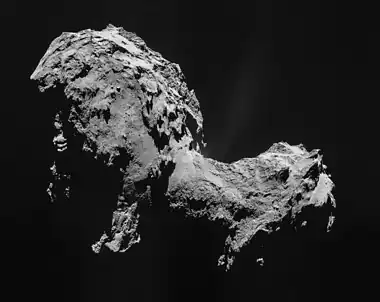| Discovery | |
|---|---|
| Discovery site | Kepler telescope |
| Discovery date | 2014 |
| Transit | |
| Orbital characteristics | |
| 1.219 AU (182,400,000 km) | |
| 704.1984 d | |
| Inclination | 89.965 |
| Star | Kepler-421 |
| Physical characteristics | |
Mean radius | 4.16 R🜨 |
Kepler-421b is an exoplanet that, as of July 2014,[1] has the longest known year of any transiting planet (704 days),[2] although not as long as the planets that have been directly imaged, or many of the planets found by the radial-velocity method, or as long as some transiting planet candidates which are listed as planets in the Extrasolar Planets Encyclopaedia (KIC 5010054 b etc.).[3] It is the first transiting-planet found near the snow-line.
Normally, at least three transits are required to confirm a planet. Due to very high signal to noise ratio, only two transits were sufficient to validate Kepler-421b to be a real planet without additional confirmation methods.
Kepler-421b is slightly larger than Uranus although its mass is not known.
References
- ↑ Kipping, D. M.; Torres, G.; Buchhave, L. A.; Kenyon, S. J.; Henze, C.; Isaacson, H.; Kolbl, R.; Marcy, G. W.; Bryson, S. T.; Stassun, K.; Bastien, F. (2014), "Discovery of a Transiting Planet Near the Snow-Line", The Astrophysical Journal, 795 (1): 25, arXiv:1407.4807, Bibcode:2014ApJ...795...25K, doi:10.1088/0004-637X/795/1/25, S2CID 119240746
- ↑ Johnson, Michele (July 21, 2014). "Astronomers Discover Transiting Exoplanet with Longest Known Year". NASA. Retrieved July 25, 2014.
- ↑ "The Extrasolar Planet Encyclopaedia — Catalog Listing". Extrasolar Planets Encyclopaedia.
Further reading
- The Longest Year, Phil Plait, Slate, July 23, 2014
- New Exoplanet Has the Longest Year Ever Discovered, July 23, 2014 at 2:15:00 PM by Niko Vercelletto, Popular Mechanics
- Astronomers discover exoplanet with longest known year, Anthony Wood, July 23, 2014, Gizmag
- First Exoplanet Discovered Beyond the “Snow Line”, by Shannon Hall on July 22, 2014, Universe Today
- Transiting Exoplanet With Longest Known Year Discovered By Kepler Mission Archived 2016-03-07 at the Wayback Machine, July 22, 2014, RedOrbit
- Discovery of a Transiting Planet Near the Snow-Line, David M. Kipping, Guillermo Torres, Lars A. Buchhave, Scott J. Kenyon, Christopher E. Henze, Howard Isaacson, Rea Kolbl, Geoff W. Marcy, Stephen T. Bryson, Keivan G. Stassun, Fabienne A. Bastien, (Submitted on 17 Jul 2014)


